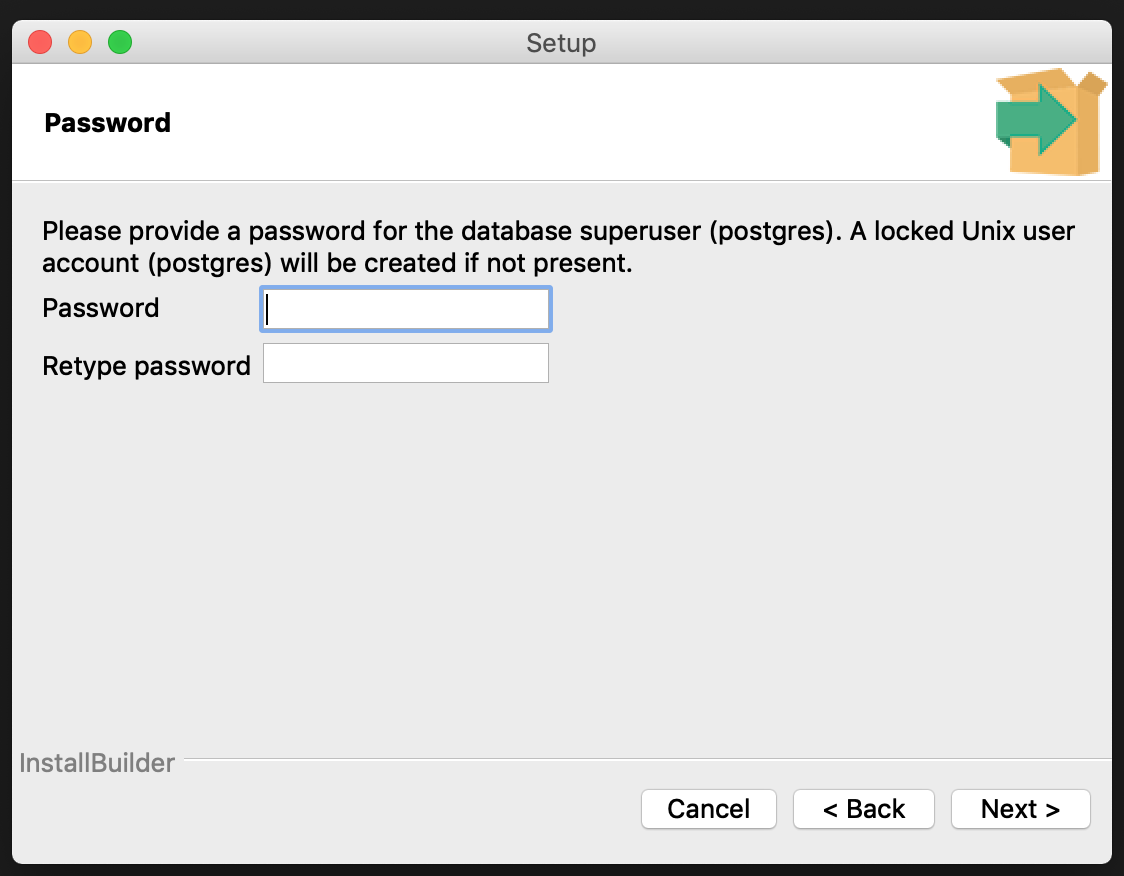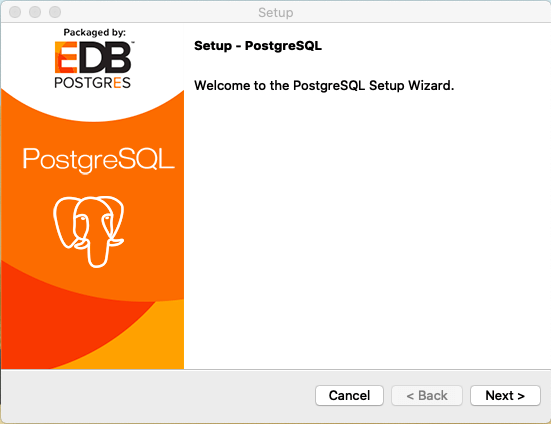
Sudo rm /etc/postgres-reg.ini; Remove the PostgreSQL folder from the system Library: sudo rm -rf /Library/PostgreSQL; Remove the PostgreSQL user. Go to System Preferences → Users & Groups → click the Lock icon and enter the administrator password to unlock settings → select the PostgreSQL and click the “-” icon. $ psql -U postgres postgres=# alter user postgres with password 'NEWPASSWORD'; postgresl=# q Reset the PostgreSQL password. If you don’t remember your PostgreSQL database password, you can follow the steps below to reset it to a new value: Change the authentication method in the PostgreSQL configuration file pghba.conf from md5 to trust. Create /Groups/postgres sudo dscl. Create /Users/postgres sudo dseditgroup -o edit -a postgres -t user postgres More advanced settings (UIDs, Group description and passwords) are possible too. In Terminal run the following command to install PostgreSQL on Mac using Homebrew. $ brew install postgres We can check the version of PostgreSQL using the psql command. $ psql -version psql (PostgreSQL) 11.5 Start PostgreSQL. To start PostgreSQL run the following command in the Terminal. $ brew services start postgres We will get a similar.
Summary: in this tutorial, we will show you step by step how to reset the password of the postgres user in PostgreSQL.
For some reason, after installing PostgreSQL, you may forget the password of the postgres user. In this case, you need to know how to reset the password.
PostgreSQL uses the pg_hba.conf configuration file stored in the database data directory (e.g., C:Program FilesPostgreSQL12data on Windows) to control the client authentication. The hba in pg_hba.conf means host-based authentication.
To reset the password for the postgres user, you need to modify some parameters in this configuration file, login as postgres without a password, and reset the password.
The following steps show you how to reset a password for the postgres user:
Step 1. Backup the pg_hba.conf file by copying it to a different location or just rename it to pg_hba.conf.bk
Step 2. Edit the pg_dba.conf file and change all local connections from md5 to trust. By doing this, you can log in to the PostgreSQL database server without using a password.
Step 3. Restart the PostgreSQL server. If you are on Windows, you can restart the PostgreSQL from Services:

Or run the following command from the window terminal:
The 'C:Program FilesPostgreSQL12data' is the data directory.
Step 4. Connect to PostgreSQL database server using any tool such as psql or pgAdmin:
PostgreSQL will not require a password to login.
Step 5. Execute the following command to set a new password for the postgres user.
Step 6. Restore the pg_dba.conf file, restart the PostgreSQL database server and connect to the PostgreSQL database server with the new password.
In this tutorial, you have learned how to reset the password of the postgres user.
NOTE: You no longer have to setup the Postgres database manually for MSF, see the updated guide on how to install the Metasploit Penetration Testing Framework with bundled embedded Postgresql database.
This page adapts the instructions on Metasploit Wiki:Postgres setup to Fedora.
- 9Troubleshooting
Allowing password authentication to access postgres on localhost
Allow the possibility for account msf_user to use password based authentication to connect to databasse msf_user. Edit '/var/lib/pgsql/data/pg_hba.conf', change:
to
See also: Postgresql Wiki: Client Authentication and Postgresql Documentation: pg_hba.conf
Starting postgres
Becoming the postgres user
Creating a database user
Creating a database
Configure Metasploit
Start the framework by running msfconsole, then enter the following commands:
Enable the database on startup
Write the database configuration to separate configuration file so the password doesn't get printed on the screen during each start of the msfconsole.Please not the attributes are prepended with spaces characters not tabs.
Use the database configuration file and connect to this database during each startup of msfconsole. Also change to the workspace of yur current pentesting project.
Using the database
Once you have database configured and connected you can use it to store information. First check the database status:
Scan the local network network:
List hosts which are in the database:
List all the db commands for the version of metasploit you have installed:
Troubleshooting
If you run into issues, or need to modify the user or database, you can always use the psql command to do this. Asusming you're using IDENT authentication (default on Fedora and RHEL), you'll have to become the 'postgres' user before you can modify users or databases with psql. (see Becoming the postgres user above)
To list databases
Mac Postgres User Password
To assign ownership of a database
To change the owner of a database, pass the following command to psql: 'ALTER DATABASE name OWNER TO new_owner'For example:
To add or change the password for a user
To change the password for a postgres user, pass the following command to psql: 'ALTER USER username WITH ENCRYPTED PASSWORD 'passwd';'For example:
To drop a database
Postgres provides a handy 'dropdb' command.
To drop a user
Postgres provides a handy 'dropuser' command.
Other useful postgres tips
Mac Postgres Password Reset
psql is a handy tool if you need to modify anything inside the postgres system. If you prefer a graphical tool, pgadmin3 is quite good. For more information, see the (extensive) documentation here: http://www.postgresql.org/docs/manuals/
psql commands
- select version(); - show the db version
- h - get help
- q - quit